|
THE THRESHING—THE LOGGING
BEE —THE RAISING BEE—MAPLE
SUGAR MAKING TIME.
THE "threshings" are in many respects much
the same now as they have been for years
back, yet in the last one hundred years they
have undergone a complete transformation. The
early settlers threshed most of their grain with
the flail. Sometimes, with certain kinds of grain, such
as oats and peas, they would cover the barn floor with
the sheaves or stalks and drive the horses and cattle
over it until the grain was all tramped out. We can
imagine now we hear the thud, thud, thud of the flail
on the threshing floor, as the farmer bent to his work.
Now and again he stopped to wipe the coursing perspiration from his
brow, or to examine the heads of the
wheat-stalks, to see whether or not they were
threshed clean. The first threshing-machine did not
come out until about seventy-five years ago, and it
was a small affair, with a narrow cylinder, fitted with
iron spikes, the rapid revolution of which, as the grain
passed through between these spikes and the spikes
in a half cylinder or concave, shook out the. grains of wheat. There being
no separators (screens or sieves for separating the grain from the chaff,
or carriers for conveying away the straw, everything went out' in a heap
at the rear of the machine. The straw was raked, shaken and pitched away,
leaving the grain and chaff on the floor. It gave considerable work to the
men and boys with the fanning-mill to separate the grain from the haff,
for it had to be put through the mill at least twice. Nowadays it usually
comes out of the threshing- machine cleaned and ready for market.
It required at least eight men to operate one of the
old threshing-machines—one man to drive the horses, one man to cut the
bands of the sheaves, one to feed, one to take away the straw and to pass
it on to three or four more men, who pitched it into the mow or on to the
straw-stack in the yard. With all this work the first machines could not
thresh more than fifty or seventy-five bushels a day, while now they can
thresh as many bushels in an hour. What a mighty difference to the farmer,
in time and labor saving.
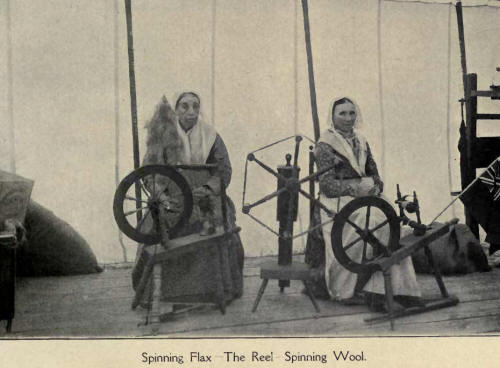
The "horse-power" stood in the yard at some distance,
and was connected with the threshing-machine by a belt and a tumbling rod
or shaft, which kept the machine in motion. The driver stood (sometimes
sat) on a table or platform in the centre of the horse-power and
flourished his long-lashed whip in the air as he touched up the lagging
horses of the four or five teams hitched to the power. Scarcely anything
could be heard above the buzz of the machinery but the crack of the
driver's whip and his strident voice as in stentorian tones he called out
to the horses, "G'ap there," "Go on," "Get up there, Bill," "G'long,"
"Whoa."
One kind of the primitive threshing-machines was
operated by tread-mills, the horses having to walk on rollers. At the
present day the horse-power has been almost entirely done away with, the
steam thresher (happily for the farmer) having taken its place.
The Logging Bee.
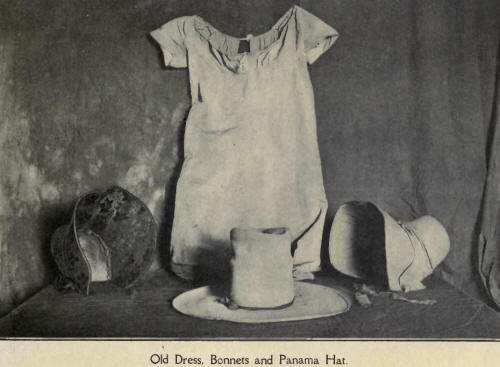
All the men in the neighborhood were invited to the
logging bee. The oxen, with a big chain dragging behind them, could be
seen coming from different directions along the side-roads and
concessions, and as many as a dozen yoke of oxen at a time might sometimes
be seen at a "logging." The farmer would prepare the iron-wood handspikes
a day or so beforehand. There was always a jug of whiskey ready for the
occasion. A logging bee without whiskey would be considered a dry afikir
indeed. After placing the chain around the end of one of the big logs the
driver would crack his whip and the log would begin to move and be
"snaked," or dragged in a serpentine direction between the stumps and
piles until it reached the spot where it was to be deposited. The "Gee!"
"flaw!" "Buck!" "Bright!" of the driver, as he encouraged and urged on his
oxen, could be heard distinctly resounding through the clearing. Besides
the driver of the oxen there were always three or four more men, with
handspikes in their hands, ready to lift the logs on top of each other.
After all had inserted their handspikes in different places along the log,
someone would call out, "Ready, boys I " and the log would be raised from
its place on the ground, and with considerable grunting and straining, and
"Now, boys!" and "Yo-he!" "Yo-he-heave! " in concert from the men, and an
extra effort, the log was finally placed on top of the pile. Skidways made
of heavy poles were placed against the lower logs for running the topmost
logs on the pile. Some of these log-heaps were three or four logs high,
and sometimes as many as seven or eight. A rough piece of land at night,
after the logging was over, would look almost as neat and tidy as a barn
floor, after it had been swept and cleaned. After a day's work among a lot
of dirty black logs the men looked more like a lot of negroes from the
south than free-born Canadian citizens. The sight of the burning log heaps
here and there, at night, looked quite picturesque and weird, and reminded
one of the picture of hades in Dante's "Inferno." In the early autumn
evenings the boys would gather around these log-heaps, roast ears of green
corn, tell stories and crack jokes. In the evening, after the wind-up of
the logging, amongst certain classes of people, there would be a spree and
a dance lasting till three or four o'clock in the morning. Night after
night the farmer could be seen going around the log-heaps, poking up the
fires, throwing chunks together, for strange to say, the log-heaps burned
best at night.
When 'there was a big field to be logged, to create
rivalry and get through with the work quickly, the logging bee took the
form of a race, with a jug of whiskey or a new yoke as a prize. The field
was staked out in lots, so many rods wide, with a yoke of oxen and a gang
of four men to each lot. Great excitement prevailed as the different gangs
strove to get through with their part of the work first. As the work went
on, the "Grog Boss" with his jug could be seen moving around among the
different gangs of men, dealing out to them their several allowances of
whiskey.
The Raising Bee.
The "raising" was quite an important event in the
neighborhood and for miles around. The people liked the excitement of such
an occasion. If the barn or house was of any size, a large number of men
(perhaps fifty or one hundred) would have to be invited to take part. The
housewife would be kept more than fully occupied for (lays beforehand
getting provisions ready of all kinds to feast the visitors and helpers.
And in the olden time it was never forgotten to supply plenty of good
Canadian whiskey, as was then the universal custom. This latter custom has
by degrees, been dropped, tea, coffee, and temperance beverages having
taken the place of the once all-popular mountain dew. The first raising
bees, no doubt, originated with the raising of the old log-houses and
barns. If a new settler came into the neighborhood, the other settlers
would gather and help him to build his house. After a number of trees had
been felled and cut up into lengths they were drawn together by oxen and
rolled up by the men on "skids" or heavy poles to their place in the walls
of the house until the house was of the required height, a man stationed
at the corners (the "corner man ") making a notch or saddle in the log, so
that it would fit over the log underneath it, hewed into a triangular
shape at the end, to receive it. For the most part the logs were left
projecting a foot or two at the corners and afterwards they were cut off,
which added to the appearance of the building. After a few years of life
in these early log cabins the settlers would build larger and better
dwellings. The first frame houses were built of heavy timber; when the
balloon fraue houses, made of scantling, first came into use the people
laughed at them, for they imagined they would blow down. It is true they
are not as substantial as the old-fashioned "frame" houses. When a farmer
decided on building, say a large barn, he would engage a carpenter, who
had experience in that line, and who would go out into the farmer's woods
and commence operations by preparing the timbers for the frame. Pine was
preferred, but if it was scarce with the farmer, other suitable woods,
such as oak, elm, tamarac, hemlock, etc., were used. The trees, which had
previously been felled and cut into required lengths, were placed on
blocks which raised them up from the ground several feet, so that they
could the more easily be gotten into shape. The first part of the work
consisted in "scoring" the log. After a portion of the bark had been
removed from one side, a chalk line was drawn along the log, after which
it was chopped into as far as this line every few inches. The wood which
had been loosened by the scoring was then hewed off by the broad axe.
After the four sides of the log had been treated in this manner, with the
exception of the timbers used for the sleepers of the house or barn, which
only required hewing on one or two sides, the timbers were removed to the
site of the future building and hewed into more perfect squares, with
mortise and tenant, so that they would be ready to fit into each other
when raising day came.
Pike-poles, ten or fifteen feet long, with sharpened
pieces of iron fitted into the end, were got ready for the men who were to
take part in the raising. On raising day, after heavy timbers or sills had
been placed on posts fixed in the ground, or on foundations of stonemason
work, the sleepers were placed across and all was ready for the raising.
The frame consisted of what was called "bents," one at each end, and two
or more in between, according to the length of the building.
bents consisted of two upright timbers or posts and one
or two cross-beams, according to the height required. They were framed and
laid together on the foundation timbers and raised in rotation. A man was
stationed with a bar in his hand at the hole mortised in the foundation
timber for receiving the upright post, and as the bent was raised, he saw
that the post went into the socket made for it. The master-builder
directed affairs, attention being given to everything he said, none of the
other men uttering a word, and with pike-poles in the hands of the men on
one side to raise and on the other side to steady, the heavy timbers were
lifted into place. The man who did the calling off was usually a man of
powerful voice and he could be heard half a mile away, as he called out,
"Now, boys," "Altogether, now," "Lift," "Yo-beave, "Steady," throwing up
his arms as he called out. After the first bent had been raised it was
stayed or braced with boards until united by "girts" to the other bents.
After the bents had all been raised, two "plates," one on each side of the
barn, for receiving the rafters, were placed on top of the posts. After
that the "purloin" plates, for giving support to the roof, were placed on
top of short posts, which stood on the crossbeams. Last of all, the
rafters, made of poles hewed on one side, were run up and put in position,
when the frame was ready for the siding and the sheeting. No iron was used
in the framing, the timbers being fastened with wooden pins, big wooden
"commanders," or mallets, being used for driving the pins into their
places. The raising was often a dangerous job, and for that reason
everything had to be done with care and caution. Sometimes there would be
a hitch, and occasionally men would lose their lives at these bees. If
everything had been properly arranged and the timbers numbered, etc., the
raising could all be done in two or three hours' time. In order to get up
an interest and have the job finished in a hurry, very frequently captains
were appointed and sides chosen, the right of first choice of men and of
location being obtained by the tossing up of a coin, or a piece of bark
marked on both sides, and a guess being made as to which side would turn
up, as black or white, wet or dry, head or tail. The race usually began at
the putting up of the plates and rafters, although in some instances they
raced from the start, each gang of men working at different ends of the
building. The race was to see who could get their part of the work done
first. The winning side would always raise a lusty cheer over their
success. With the hooting and shouting that sometimes took place when the
race was going on, the excitement was intense and began at the very
commencement and continued with increasing intensity until the last rafter
was in place. Men sometimes lost their heads at these bees in their
anxiety to get ahead of the opposite side, and ill consequences were the
result. A friend mentioned to the writer that he once saw a man—by
mistake, of course—saw off the log on which he was sitting,. in his haste
to overcome his antagonists on the other side. Some of the men who were
accustomed to such jobs would climb over the beams and plates, as lively
as a lot of. squirrels, and oftentimes the captain would ride the
cross-beam of the bent as it was being raised Those on the winning side
were given the privilege of going to supper first. Usually in the evening,
after the raising was over, there would be a dance on the floor of the
newly-raised barn.
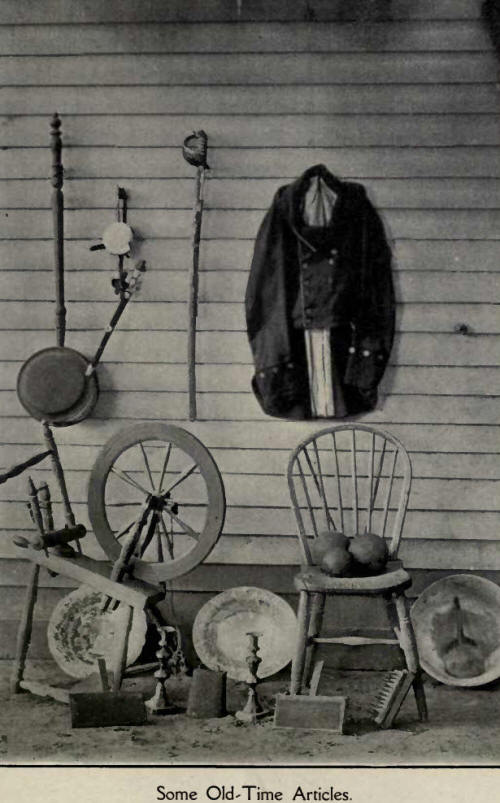
Maple Sugar Making Time.
During the latter part of February and the first of
March vegetation begins to awaken from its long rest, and again prepares
to put on its mantle of green. The sap commences to flow back from the
roots of the trees to the branches. It is aided in this by the heat and
light of the sun, for the flow is generally greatest in the daytime, and
particularly so on a mild, sunny day following a frosty night. The early
settlers took advantage of this passing up of the sap to obtain their
year's supply of maple sugar. Often it was the only kind they could
obtain. Maple sugar making time was to them one of the busiest and most
romantic seasons of the year, and during this season they spent
considerable of their time in the "sugar bush." The sap was boiled down in
big iron kettles, three or four kettles being required for one boiling.
The sap in the first kettle, after it had been evaporated down to syrupy
consistence, was poured into the second, and so on, to make room for a
fresh supply of sap.* Sitting on logs out in the woods beside the boiling
kettles, the watchers had often a weary wait until into the night for the
time to "sugar off." There was nothing to break the stillness but,
perhaps, the hoot- in of of the owls in the pines or the dreaded howling
of the wolves in the distance.
The children always looked forward to this season of
the year with pleasure, for they knew they could then get their full of
nature's delicious nectar without money and without price. It frequently
brought the young folks together in gatherings called "taffy pulls."
Following closely on St. Valentine's Day, when the birds are supposed to
mate and when Cupid's darts go straight to the mark, many matches were the
result of these happy gatherings of the young people. Just before the
boiling liquid reached the point when the sugaring off was done, a portion
of it was taken out of the kettle and spread on the snow or a piece of
ice, when it would harden into taffy, clear as crystal and with a flavor
like nectar, fit for the gods. After the sap had been boiled down to a
syrupy consistence, a portion of it was removed for use as molasses. And
how the old folks, as well as the young, did enjoy this maple syrup along
with their 'buckwheat pancakes" and "griddle cakes:"
The sugar was moulded into cakes of various sizes and
shapes, from the big loaf weighing ten or fifteen pounds down to the
little cakes made in the crinkled patty-pans for the children.
Speaking of sugar making time recalls to mind an old
song that was sung years ago, with a chorus something as follows:
"Oh it's babble, bubble, bubble, bubble, bubble goes
the pan,
Furnish better music for the season if you can;
See the
golden billows, watch their ebb and flow,
Oh is not it the jolliest fun
the sugar makers know!"
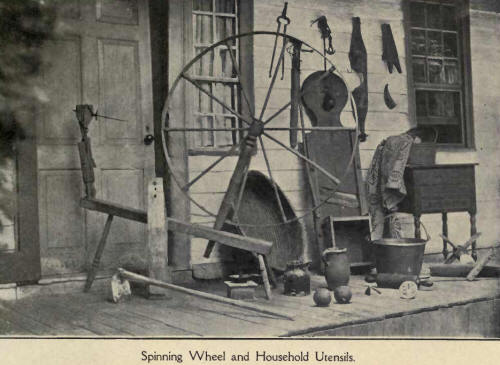
The gathering of the sap was, perhaps, the most arduous
part of the work. Holes had to be bored into the trees with an auger, and
into these wooden spouts, or "spiles," for running off the sap were
inserted. In early pioneer times a slanting notch was made in the tree
with a hatchet; beneath this notch was made a hole with a semi-circular
iron gouge, the spiles which were driven into these holes being split out
of a block of pine or cedar wood with the same instrument. Troughs,
hollowed out of short lengths of basswood, pine or ash logs, were placed
at the base of the tree to catch the sap. Later on, wooden pails, made for
the purpose, oftentimes by the farmer himself if he had any notion for
coopering, took the place of these troughs. When the sap troughs or"
buckets" became full, the sap was collected and poured into barrels or
into big wooden troughs hollowed out of a log of wood. With a wooden yoke
placed over his shoulders and a pail attached to a rope at each end, one
of the men helpers would go around among the trees gathering the sap.
Sometimes a horse and sleigh, or jumper (home-made sleigh), with a barrel
on, was driven around through the woods to collect the sap, for the snow
used to generally lie deep in the woods in those days.
Maple sugar making is still quite an industry at the
present day, but in the modern "sugar camp" things are much more
convenient than formerly. In the early days a rough shed, open on one side
and covered with brush and boughs, was made out in the woods to shelter
the watchers, and there they sat and watched when the weather was cold and
rough. Nowadays an arch of brick is built; on this is placed an
evaporating pan, and over all is built a shed, which not only protects the
sugar makers from the inclemency of the weather, but also prevents the
dead leaves and twigs from getting into the kettle. There are many other
additional conveniences as well, which make the making of sugar much
easier at the present day than formerly.
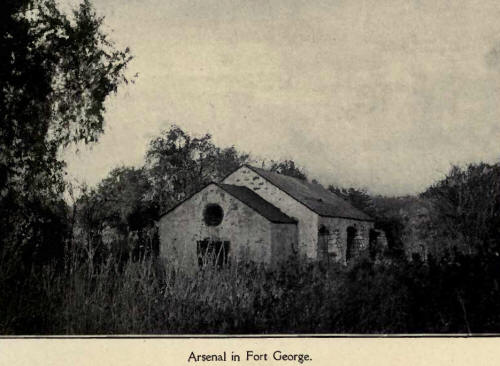
Of the many different species of maple there is only
one species from which sugar can be obtained. It is commonly known as the
sugar, rock, or hard maple. The average yield of a healthy sugar tree
would be about a gallon of syrup in a season. A gallon of syrup makes
seven pounds of sugar, although, if the syrup be very thick, it may make
as much as ten pounds. Two pails of sap is supposed to make a pound of
sugar, although the strength of the saparies according to the season and
the locality. It is well understood that the earliest sap which rises is
the strongest and makes the lightest colored sugar and the sweetest and
nicest flavored molasses. Before the sugar became hard it was sometimes
stirred with a stick. This crumbled it up so that it resembled the light
brown muscovada sugar of commerce, which it was often made to take the
place of. The sap which is obtained just before the buds on the trees are
about to burst is often made into vinegar.
|

